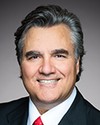Thank you very much, Mr. Sabia.
Thank you, Mr. Chahal.
Next we'll go to Dr. Lewis.
Dr. Lewis, the floor is yours. You have five minutes.
Evidence of meeting #69 for Transport, Infrastructure and Communities in the 44th Parliament, 1st Session. (The original version is on Parliament’s site, as are the minutes.) The winning word was sabia.
A recording is available from Parliament.
12:20 p.m.
Liberal

The Chair Liberal Peter Schiefke
Thank you very much, Mr. Sabia.
Thank you, Mr. Chahal.
Next we'll go to Dr. Lewis.
Dr. Lewis, the floor is yours. You have five minutes.
12:20 p.m.
Conservative

Leslyn Lewis Conservative Haldimand—Norfolk, ON
Thank you.
I'm going to ask Ms. Therrien a question about the way in which she perceives that the bank has moved away from its mandate, its original mandate, and has moved into a relationship that has changed its mandate from what was created by the advisory council, starting from the advisory council through to its intermingling with McKinsey.
12:20 p.m.
Senior Research Officer, Canadian Union of Public Employees
Again, when the current federal government, back in the election period in 2015, floated the idea of the public infrastructure bank, the vision at that point and the stated intention was that the mandate of the bank would be to provide low-cost loans to local governments to finance new public infrastructure and strengthen their communities. That's what was originally proposed back in the platform of the government in 2015.
Again, with the involvement of McKinsey and BlackRock, there was this shift to focus on trying to attract private capital. There was this “pie in the sky” promise that there would be a 5:1 ratio of private dollars coming in to assist with that. We've seen, over the five years, that this has not been the case. In fact, the bank has been struggling to maintain even a 1:1 ratio of public-to-private dollars.
The result of that is that municipalities, as we heard, some of them are being declined for the projects they're applying for, which again is very necessary infrastructure. We all live in places where we know the roads are aging, and all the pipes and underground infrastructure that we can't see needs repair. If projects are not being accepted because they don't have that requisite private partner, that's a problem. Again, even having a private partner, we've seen in different municipalities the issues that can go along with that. Mapleton's a big example of that. There are several others throughout the country.
Again, the main purpose of a public bank is that they have a very public focus. The ones that have been successful, which we see primarily over in Europe but certainly in other countries and continents, do have that. Their guarantees are backed by the municipalities or the countries that are signatories to those public banks. That ensures the funding is flowing directly to the municipalities, to the communities, to those public projects that really need to be financed, without having to go through the hoops of having private investment involved. Then again, CUPE is always concerned, as we should be, about the threat of increased privatization of public services.
Transit's an interesting one. It's great that there's funding coming in to help make transit more sustainable in terms of being environmentally sustainable. Transit systems in North America in particular don't make money. They're never going to make money. They're an essential service that municipalities are bound to provide. Again, if we bring private capital that has an interest in making money into something like transit, they're not going to make money on that. The end result is going to be higher user fees and what we've seen in other cities: cutting hours and cutting the services that people rely on.
12:25 p.m.
Conservative

Leslyn Lewis Conservative Haldimand—Norfolk, ON
Thank you for that answer.
I want to pose a question to both Mr. Brown and Ms. Raitt.
The purpose of this study is to look at how the bank started and this knowledge of the bank and McKinsey contracts. You both gave evidence today and it appears that neither of you have any knowledge of the beginning of the bank and its relation to McKinsey contracts. Is that correct?
I'll start with Ms. Raitt.
12:25 p.m.
Co-Chair, Coalition for a Better Future, As an Individual
You are correct, Dr. Lewis.
12:25 p.m.
Conservative

Leslyn Lewis Conservative Haldimand—Norfolk, ON
Thank you.
Mr. Brown, would you also say that the evidence you gave does not really tie into the subject of this study, which pertains to your knowledge of McKinsey contracts at the beginning of the bank? You do not have that expertise. Is that right, Mr. Brown?
12:25 p.m.
Mayor of Brampton, As an Individual
No, I cannot speak to McKinsey contracts and the start of the bank. I can only speak to how this Infrastructure Bank has helped the city of Brampton.
12:25 p.m.
Conservative
12:25 p.m.
Conservative

Leslyn Lewis Conservative Haldimand—Norfolk, ON
Mr. Sabia, can you tell me what other engagements you've had with McKinsey over the years, especially while you were with the Infrastructure Bank?
12:25 p.m.
Member, Advisory Council on Economic Growth
I was only chair of the board of the Infrastructure Bank for a number of months. I believe the only work that was done, that I was aware of at the time, was the work that we've already discussed to help accelerate the bank going forward. To my recollection, that is all there is.
12:25 p.m.
Liberal

The Chair Liberal Peter Schiefke
Thank you very much, Mr. Sabia.
Thank you, Dr. Lewis.
Mr. Iacono, you have the floor for five minutes.
12:25 p.m.
Liberal

Angelo Iacono Liberal Alfred-Pellan, QC
Thank you, Mr. Chair.
Thank you to the witnesses for being here this morning.
My first question is for Ms. Raitt.
As the former Minister of Labour, Natural Resources and Transportation, you have a lot of experience with federal infrastructure on these issues.
Could you talk about Canada's infrastructure deficit in general and why attracting private investment and having public-private partnerships is critical to addressing these needs quickly across the country?
12:25 p.m.
Co-Chair, Coalition for a Better Future, As an Individual
Thank you very much, Mr. Chair. I'd be happy to address the question.
I do agree that there is an infrastructure gap. It's not just in terms of what we need for now and not just in terms of our ports and our airports, which are traditionally what you look at with respect to infrastructure. As governments around the world are making public policy decisions to move to net zero, added investment will also be needed to take on that greater challenge—and it is a huge challenge.
The amount of infrastructure that has to change is actually something that is both breathtaking and mind-blowing at the same time. It's difficult to contemplate how all of this money is going to come from a taxpayer or a ratepayer, because they simply can't foot the bill. [Technical difficulty—Editor] in some of these changes. That is happening and as a result, I do think that the gap that we already have, which continues to widen [Technical difficulty—Editor]. As a result, moving towards a net-zero future is going to have to be addressed by partnerships between the federal government and the private sector.
I'm agnostic on how that is accomplished as a public policy or a tool of the government. I do believe every government has the ability to make its own choices. I just wish and hope that, in making these choices, we don't lose a period of time because the race is on. We have to make sure we keep our focus and our eye on the ball.
I would agree with Mr. Sabia, and I think it's important to note, that we have seen a fundamental change in the Canada Infrastructure Bank in the past three years. It is putting projects out and it does have a very professional team and staff that are capable of doing so. You will see that I have made public comments with respect to that very matter over the past year and a half. As part of my job at CIBC, we do work with the Canada Infrastructure Bank.
12:25 p.m.
Liberal

Angelo Iacono Liberal Alfred-Pellan, QC
Thank you.
My next question is for Mr. Sabia.
Could you talk about the infrastructure deficit in Canada and why attracting private investment and having public-private partnerships is critical to addressing these needs across the country?
12:30 p.m.
Member, Advisory Council on Economic Growth
Yes, of course.
As I was saying a few minutes ago, and as Ms. Raitt was saying, there is a very large gap between the need for infrastructure development in Canada and the ability of governments to make the necessary investments to meet that need. This begs the question: how do we make the necessary investments, and do so in a fiscally responsible manner? I'm not just talking about the government of Canada, but also the provinces. Indeed, no government has the financial resources to make all the necessary investments.
That is why it is important to distinguish between projects that, because of their nature, can get specialized financing from an institution like the Infrastructure Bank of Canada, and more traditional infrastructure projects. Those have to be funded directly, either in the traditional way, as I was saying, by governments.
It's a way to better utilize the resources of all governments in trying to address this challenge, which is so important to increasing productivity and, by extension, economic growth in Canada.
12:30 p.m.
Liberal

The Chair Liberal Peter Schiefke
Thank you very much, Mr. Iacono.
Mr. Barsalou-Duval, you have the floor for two and a half minutes.
12:30 p.m.
Bloc

Xavier Barsalou-Duval Bloc Pierre-Boucher—Les Patriotes—Verchères, QC
Thank you, Mr. Chair.
My question is for Mr. Sabia.
Earlier, I asked you how a $1.28 billion grant for the REM turned into a $1.28 billion loan from the Infrastructure Bank. I asked you that question because I'm guessing it didn't happen overnight. You must have received a call and negotiations took place.
With whom did it happen, and how was the decision taken? How does a grant turn into a loan?
12:30 p.m.
Member, Advisory Council on Economic Growth
That was a decision made by the government and, indeed, the government informed us of that change.
However, frankly, when I was at the Caisse de dépôt et placement du Québec, the CDPQ, we were quite happy with the government's participation, but it was their decision to make that investment through the Infrastructure Bank. As I said, it was not the CDPQ's decision at all, but it was a reasonable way for the government of Canada to facilitate the development of this transit project, which is very important for the future of Montreal.
12:30 p.m.
Bloc

Xavier Barsalou-Duval Bloc Pierre-Boucher—Les Patriotes—Verchères, QC
Thank you, that answers my question.
Last week, former Minister McKenna appeared before the committee and said that the Infrastructure Bank made its investment decisions independently of the government. I'm still surprised, though, because now you're telling me that it was the federal government which made the decision to withdraw a grant and that it required the Infrastructure Bank to participate in the financing of the REM project.
What does that say about the true independence of the Infrastructure Bank from the government?
12:30 p.m.
Member, Advisory Council on Economic Growth
That's a good question.
Given the importance and size of this investment, at the time, there was good collaboration between the government and the Infrastructure Bank, because it was just at the beginning of the Bank's operations. I think it was just a way to come to a decision on a large investment to facilitate a large project.
That said, I am not in a position to comment, because I was not there.
12:30 p.m.
Bloc

Xavier Barsalou-Duval Bloc Pierre-Boucher—Les Patriotes—Verchères, QC
The financial structure of your project for the REM must nevertheless have had an impact. A loan comes with interest, whereas a subsidy has no cost. I imagine that, for Quebec taxpayers, this decision by the federal government ultimately had a financial impact.
12:35 p.m.
Member, Advisory Council on Economic Growth
Given the nature of the financing and the interest rate, it did not have a very significant impact on the financial performance of the REM or on returns to the Caisse's [inaudible].
12:35 p.m.
Liberal

The Chair Liberal Peter Schiefke
Thank you very much, Mr. Sabia.
Thank you, Mr. Barsalou-Duval.
Next, we have Mr. Bachrach.
Mr. Bachrach, the floor is yours. You have two and a half minutes.